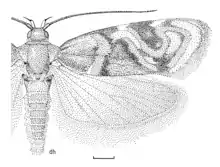| Hierodoris electrica | |
|---|---|
 | |
| Female lectotype | |
| Scientific classification | |
| Domain: | Eukaryota |
| Kingdom: | Animalia |
| Phylum: | Arthropoda |
| Class: | Insecta |
| Order: | Lepidoptera |
| Family: | Oecophoridae |
| Genus: | Hierodoris |
| Species: | H. electrica |
| Binomial name | |
| Hierodoris electrica | |
| Synonyms[1] | |
| |
Hierodoris electrica is a moth of the family Oecophoridae.[1] It was described by Edward Meyrick in 1889. It is endemic to New Zealand, where it has been reported from the northern and southern parts of the South Island. The larva of H. electrica has yet to be described. The wingspan is between 15 and 16.5 mm. The ground colour of the forewings is dark brown, with narrow yellow scales overlaying this base colour. The hindwings are brown. The known larval host species is Olearia nummulariifolia.
Taxonomy
This species was first described by Edward Meyrick in 1889 and named Heliostibes electrica using two specimens collected at Mount Arthur at an altitude of 4700 ft.[2] In 1988 J. S. Dugdale moved this species to the genus Hierodoris.[3] The female lectotype specimen, designated by Robert Hoare in 2005, is held at the Natural History Museum, London.[3][1]
Description
.jpg.webp)

Meyrick described the adults of this species as follows:
♀. 16–17mm. Head, palpi, thorax, and abdomen dark fuscous, slightly sprinkled with yellowish. Antennae and legs dark fuscous, posterior tibiae yellow-whitish. Forewings elongate, moderate, costa gently arched, apex rounded, hind-margin obliquely rounded; dark fuscous, strewn with ochreous-yellow hair-scales in irregular patches; a leaden-metallic line from 1⁄3 of costa to 2⁄5 of inner margin, angulated outwards in middle; a sinuate leaden-metallic line from above middle of disc to anal angle; a leaden-metallic line from middle of costa-obliquely outwards more than half across wing, thence curved round to touch a whitish dot on costa at 3⁄4, and continued in a strong curve near and parallel to costa and hindmargins to anal angle; space between first and second lines, and within first curve of third line, less strewn with yellow scales and therefore darker than rest of wing: cilia light grey, rather shining. Hindwings rather dark fuscous, somewhat bronzy; cilia light shining grey.[2]
The wingspan is 15–16.5 mm.[1] The ground colour of the forewings is dark brown, largely overlain by narrow yellow scales.[1] The hindwings are brown, but darker exteriorly.[1] The larva of H. electrica has yet to be described.[1]
Distribution
This species is endemic to New Zealand and has been found in the northern and southern areas of the South Island.[1][4] However this species has not been collected in Buller, Westland, or Canterbury.[1]
Behaviour
Adults of this species are on the wing from mid December until the end of February.[5] This moth is day flying and has been seen on hot, sunny days.[5] It was regarded by George Hudson as being rare and Robert Hoare states it appears to be rarer than its sister species H. s-fractum.[5][1]
Hosts
The larvae possibly feed on Ozothamnus species. However, reared specimens have also emerged from a spinning on Olearia nummulariifolia.[1]
References
- 1 2 3 4 5 6 7 8 9 10 11 12 Robert J. B. Hoare (24 December 2005). "Hierodoris (Insecta: Lepidoptera: Gelechioidea: Oecophoridae), and overview of Oecophoridae" (PDF). Fauna of New Zealand. Manaaki Whenua – Landcare Research. 54: 39–40. doi:10.7931/J2/FNZ.54. ISSN 0111-5383. OCLC 946510444. Wikidata Q44994400. Archived from the original (PDF) on 20 February 2021.
- 1 2 Edward Meyrick (May 1889). "Descriptions of New Zealand Micro-Lepidoptera". Transactions and Proceedings of the New Zealand Institute. 21: 157. ISSN 1176-6158. Wikidata Q109555851.
- 1 2 John Stewart Dugdale (23 September 1988). "Lepidoptera - annotated catalogue, and keys to family-group taxa". Fauna of New Zealand. Department of Scientific and Industrial Research. 14: 89. doi:10.7931/J2/FNZ.14. ISSN 0111-5383. Wikidata Q45083134.
- ↑ "Hierodoris electrica (Meyrick, 1889)". www.nzor.org.nz. 2021. Retrieved 2021-11-12.
- 1 2 3 George Vernon Hudson (1928), The butterflies and moths of New Zealand, Illustrator: George Hudson, Wellington: Ferguson and Osborn Limited, p. 306, LCCN 88133764, OCLC 25449322, Wikidata Q58593286